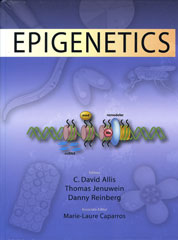`
Congratulations to Liling Wan on her new position at UPenn!
Congratulations to Richard Phillips on his new position at UPenn!
Congratulations to Doug Barrows on his new position at RU!
Click here to read David Allis' NAS member profile (Published in PNAS, April 25, 2006)

Though every gene exists within every cell in the human body, only a small percentage of genes is activated in any given cell. To manage this genetic information efficiently, nature has evolved a sophisticated system that facilitates access to specific genes. This system relies on a DNA-histone protein complex called chromatin to efficiently package the genetic information that exists within each cell.
Chromatin, the repeating polymer of DNA and associated histone proteins, is the physiological template of our genome. As such, elaborate mechanisms have evolved to introduce meaningful variation into chromatin for purposes of altering gene expression and other important biological processes, including the repair of damaged and chromosomal dynamics. Introduction of covalent histone modifications, chromatin remodeling by ATP-dependent complexes, and utilization of histone variants are three major mechanisms by which variation can be introduced into the chromatin fiber. Together, this variation might form a "histone code" that remains poorly understood. Two general types of mechanisms have been proposed to explain the function of covalent histone modifications: 1) "trans" mechanisms that involve the binding of effectors that engage specific covalent marks in a context-dependent fashion, and 2) "cis" mechanisms that involve structural alterations in the chromatin fiber by changing internucleosomal contacts.  One long-range goal of our research program is to gain mechanistic insight into the function(s) of histone covalent modifications in cis and trans pathways. We favor the general view that histone proteins are major carriers of epigenetic information. The fundamental structure of chromatin suggests that all DNA-templated processes, including a wide range of epigenetic phenomena, are influenced by chromatin alterations with far-reaching implications for human biology and disease, notably cancer.
One long-range goal of our research program is to gain mechanistic insight into the function(s) of histone covalent modifications in cis and trans pathways. We favor the general view that histone proteins are major carriers of epigenetic information. The fundamental structure of chromatin suggests that all DNA-templated processes, including a wide range of epigenetic phenomena, are influenced by chromatin alterations with far-reaching implications for human biology and disease, notably cancer.
It is only now, after the description of oncogenes in the 1980s, tumor suppressor genes in the 1990s, and the recent sequencing of the human genome, that attention will focus more squarely on the molecular engines which drive the mutation, loss, and aberrant regulation of genes resulting in cancer. Chromatin modifications, and the regulation of the enzymes responsible for adding or subtracting them, are poised to take center stage in the study of cancer in the current post-genomic or epigenomic era. Moreover, the implications of chromatin and its many and dynamic modifications are just beginning to be appreciated in clinical oncology. The identification of altered DNA methylation and histone acetylase activity in a range of human cancers, coupled with the use of HDAC inhibitors in the treatment of leukemia and epithelial malignancies make a compelling argument. It is clear that the regulatory signals provided by chromatin modifications will revolutionize our view of cancer as new models of epigenetic carcinogenesis are advanced. We favor the view that there exists an epigenetic indexing system for our genome, or a 'histone code,' that represents a fundamental regulatory mechanism that acts outside of the DNA itself. We predict that this 'code' impacts on most, if not all, chromatin-templated processes with far-reaching consequences for cell fate decisions and for normal and pathological development. We are interested in unraveling the 'histone code' in all its complexity and we are currently investigating different histone modifications and their biological roles in a variety of organisms ranging from unicellular (Tetrahymena, budding yeast) to multicellular eukaryotes (Drosophila, mammalian cells). Since histone proteins are highly conserved through evolution, their post-translational modifications are also well conserved.

This nucleosome cross stitch was created by graduate student Lindsey Baker, based on Luger et al. (1997) Nature, 389, 251-260. It is proudly displayed in the office of David Allis.

Dave wishes that his office whiteboard (shown above) had been chosen for The Amazing Spiderman Movie!
Film Still:The Amazing Spiderman.Dir.Marc Webb.Sony/Columbia,2012.Web. December, 13. 2012.
